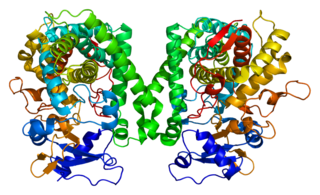Related Research Articles

Cytochromes P450 are a superfamily of enzymes containing heme as a cofactor that mostly, but not exclusively, function as monooxygenases. In mammals, these proteins oxidize steroids, fatty acids, and xenobiotics, and are important for the clearance of various compounds, as well as for hormone synthesis and breakdown. In 1963, Estabrook, Cooper, and Rosenthal described the role of CYP as a catalyst in steroid hormone synthesis and drug metabolism. In plants, these proteins are important for the biosynthesis of defensive compounds, fatty acids, and hormones.

Cytochrome P450 2A6 is a member of the cytochrome P450 mixed-function oxidase system, which is involved in the metabolism of xenobiotics in the body. CYP2A6 is the primary enzyme responsible for the oxidation of nicotine and cotinine. It is also involved in the metabolism of several pharmaceuticals, carcinogens, and a number of coumarin-type alkaloids. CYP2A6 is the only enzyme in the human body that appreciably catalyzes the 7-hydroxylation of coumarin, such that the formation of the product of this reaction, 7-hydroxycoumarin, is used as a probe for CYP2A6 activity.

Cytochrome P4502C8 (CYP2C8) is a member of the cytochrome P450 mixed-function oxidase system involved in the metabolism of xenobiotics in the body. Cytochrome P4502C8 also possesses epoxygenase activity, i.e. it metabolizes long-chain polyunsaturated fatty acids, e.g. arachidonic acid, eicosapentaenoic acid, docosahexaenoic acid, and Linoleic acid to their biologically active epoxides.

Cholesterol side-chain cleavage enzyme is commonly referred to as P450scc, where "scc" is an acronym for side-chain cleavage. P450scc is a mitochondrial enzyme that catalyzes conversion of cholesterol to pregnenolone. This is the first reaction in the process of steroidogenesis in all mammalian tissues that specialize in the production of various steroid hormones.

Steroid 21-hydroxylase is an enzyme that hydroxylates steroids at the C21 position and is involved in biosynthesis of aldosterone and cortisol. The enzyme converts progesterone and 17α-hydroxyprogesterone into 11-deoxycorticosterone and 11-deoxycortisol, respectively, within metabolic pathways that ultimately lead to aldosterone and cortisol. Deficiency in the enzyme may cause congenital adrenal hyperplasia.

In enzymology, a sterol 14-demethylase (EC 1.14.13.70) is an enzyme of the Cytochrome P450 (CYP) superfamily. It is any member of the CYP51 family. It catalyzes a chemical reaction such as:

Cytochrome P450 2C18 is a protein that in humans is encoded by the CYP2C18 gene.

Cytochrome P450 2F1 is a protein that in humans is encoded by the CYP2F1 gene.

The halloween genes are a set of genes identified in Drosophila melanogaster that influence embryonic development. All of the genes code for cytochrome P450 enzymes in the ecdysteroidogenic pathway (biosynthesis of ecdysone from cholesterol). Ecdysteroids such as 20-hydroxyecdysone and ecdysone influence many of the morphological, physiological, biochemical changes that occur during molting in insects.
CYP303A1 is an insect gene belongs to the cytochrome P450 family, first found in Drosophila melanogaster, highly expressed in pupal stage. Its ortholog also found in Locusta migratoria.
Cytochrome P450, family 105, also known as CYP105, is a cytochrome P450 monooxygenase family in bacteria, predominantly found in the phylum Actinomycetota and the order Actinomycetales. The first three genes and subfamilys identified in this family is the herbicide-inducible P-450SU1 and P-450SU2 from Streptomyces griseolus and choP from Streptomyces sp's cholesterol oxidase promoter region.
Cytochrome P450, family 107, also known as CYP107, is a cytochrome P450 monooxygenase family in bacteria, found to be conserved and highly populated in Streptomyces and Bacillus species. The first gene identified in this family is Cytochrome P450 eryF (CYP107A1) from Saccharopolyspora erythraea. Many enzymes of this family are involved in the synthesis of macrolide antibiotics. The members of this family are widely distributed in Alphaproteobacteria, cyanobacterial, Mycobacterium, Bacillota, and Streptomyces species, which may be due to horizontal gene transfer driven by selection pressure.
Cytochrome P450, family 11, also known as CYP11, is a chordate cytochrome P450 monooxygenase family. This family contains many enzymes involved in steroidogenesis, such as Cholesterol side-chain cleavage enzyme (CYP11A1), Steroid 11β-hydroxylase (CYP11B1) and Aldosterone synthase (CYP11B2). CYP11 can be divided into A to E five subfamilies, and CYP11A are the ohonologues to CYP11C, which duplicated during 2R event, and the tetrapod's CYP11B evolved from CYP11C of its fish ancestors, CYP11D and F found in amphioxus. These are not the typical CYP subfamilies, which share at least 40% amino acid identity, members between CYP11A and B subfamily are only 37.5-38.8% identical, and the CYP11D and E genes seen in modern lancelet is 39% identical to catfish CYP11A1.
Cytochrome P450, family 16, also known as CYP16, is an animal cytochrome P450 monooxygenase family. This family was the last vertebrate CYP family recognized, and is absent from the mammal and zebrafish genome, but found in other fish and many invertebrates including some very old branches, such as Trichoplax and Oscarella carmela. Synteny mapping of CYP16 family members showing linkages to CYP26 family members, means the tetrapod's CYP26 may evolved from CYP16 of fish.
Cytochrome P450, family 9, also known as CYP9, is a cytochrome P450 family found in Insect genome, CYP9 and insect CYP6 family belong to the same clan as mammalian CYP3 and CYP5 families. The first gene identified in this family is the CYP9A1 from the Heliothis virescens, which is involved in thiodicarb insecticide resistance. Subfamily CYP9A in Lepidopteran play important roles in insecticide resistance, can metabolize esfenvalerate efficiently.
Cytochrome P450, family 18, also known as CYP18, is an animal cytochrome P450 family found in insect genomes. It is involved in insecticide resistance. The first member gene identified was CYP18A1, from a Drosophila melanogaster fly, acting as a dimethylnitrosamine demethylase.
Cytochrome P450, family 12, also known as CYP12, is a cytochrome P450 family found in insect genome belongs to Mitochondrial clan CYPs, which is located in the inner membrane of mitochondria(IMM). The first gene identified in this family is the CYP12A1 from the Musca domestica, which is involved in insecticide resistance. CYP12A1 protein localization in mitochondria by immunohistochemistry and absolute dependence on mitochondrial electron donors adrenodoxin reductase and adrenodoxin.
Cytochrome P450, family 15, also known as CYP15, is an animal cytochrome P450 family found in insect genome, involved in juvenile hormone biosynthesis. The first gene identified in this family is the DpCYP15A1 from the Diploptera punctata, encodes an epoxidase of methyl farnesoate, a precursor of juvenile hormone, alone with its ortholog TcCYP15A1 in Tribolium castaneum.
Cytochrome P450, family 305, also known as CYP305, is an animal cytochrome P450 family found in insect genome. The first gene identified in this family is the CYP305A1 from the Drosophila melanogaster.
Cytochrome P450, family 27, also known as CYP27, is a Deuterostome cytochrome P450 monooxygenase family found in human genome. This family belongs to Mitochondrial clan CYPs, which is located in the inner membrane of mitochondria(IMM). There are three members in the human genome, CYP27A1, CYP27B1 and CYP27C1, and an ortholog CYP27F1 in sea urchins, Strongylocentrotus purpuratus.
References
- ↑ Nelson, DR (November 1998). "Metazoan cytochrome P450 evolution". Comparative Biochemistry and Physiology. Part C, Pharmacology, Toxicology & Endocrinology. 121 (1–3): 15–22. doi:10.1016/s0742-8413(98)10027-0. PMID 9972448.
- ↑ Dermauw, W; Van Leeuwen, T; Feyereisen, R (December 2020). "Diversity and evolution of the P450 family in arthropods". Insect Biochemistry and Molecular Biology. 127: 103490. doi: 10.1016/j.ibmb.2020.103490 . PMID 33169702. S2CID 226297890.
- ↑ Nelson, DR (2006). Cytochrome P450 nomenclature, 2004. Methods in Molecular Biology. Vol. 320. pp. 1–10. doi:10.1385/1-59259-998-2:1. ISBN 1-59259-998-2. PMID 16719369.
- ↑ Le Goff, G; Hilliou, F (March 2017). "Resistance evolution in Drosophila: the case of CYP6G1". Pest Management Science. 73 (3): 493–499. doi:10.1002/ps.4470. PMID 27787942.
- ↑ Shi, Y; Jiang, Q; Yang, Y; Feyereisen, R; Wu, Y (August 2021). "Pyrethroid metabolism by eleven Helicoverpa armigera P450s from the CYP6B and CYP9A subfamilies". Insect Biochemistry and Molecular Biology. 135: 103597. doi:10.1016/j.ibmb.2021.103597. PMID 34089822. S2CID 235353940.